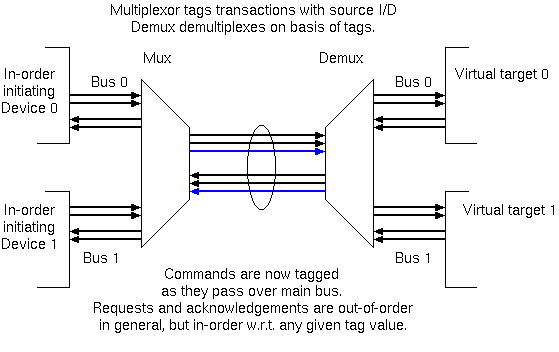
Some initiators, particularly out-of-order CPU cores, issue multiple outstanding reads and can do useful work as soon as any of them are serviced.
Some targets, particularly DRAM, can provide better performance by servicing requests out-of-order.
If we multiplex a pair of in-order busses onto a common bus, yet tag all of the traffic from each bus on the common bus according to its in-order initiator, we have a tagged, out-of-order bus.

The semantics are that for any given tag the requests and replies must be kept in order.
The devices on the left may be separate initiator blocks, like processors and DMA controllers, or they may be different load/store ports on a common IP block, or, in theory, any mix.
For the targets on the right, there is no difference between demultiplexing to separate in-order targets and a single target that understands tags.
The tags above are used to correlate results to replies over an out-of-order bus. To preserve sequential consistency between, say, separate load/store ports on a CPU, which would have their own IDs a fence mechanism of some sort is also needed.
Fences preserve RaW and WaW orderings: no transaction is allowed to overtake others in a way that would make it jump over a fence in the time domain. (In the OCP/BVCI bus, tag numbers are/were used in a different way from AXI: a fence is implied when an initiator increased a tag number.) On the AXI bus there are no fences. Instead, an initiator must just wait for all outstanding responses to come back before issuing a transaction on any of its load/store ports that is after a fence.
For AXI load-linked, store-conditional and other atomic operations, the command fields in the issueing channels contain additional nets and code points that indicate whether the transaction is exclusive in this way.
| 76: (C) 2008-17, DJ Greaves, University of Cambridge, Computer Laboratory. |